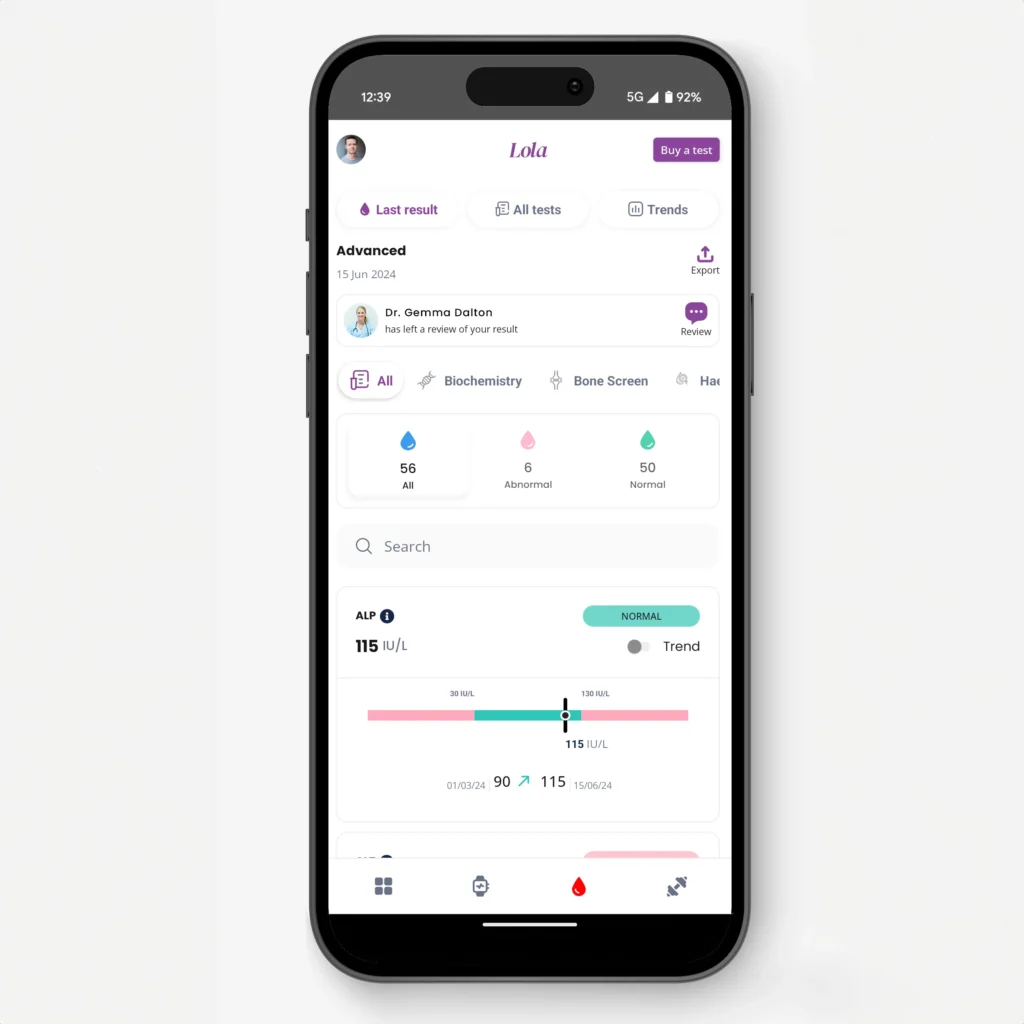Lola Health Baseline

BaselineThe Baseline is the ideal test for individuals who want to take proactive steps toward managing their health. It offers a comprehensive overview with 45 essential biomarkers that evaluate a wide range of health areas, including cholesterol levels, diabetes risk, vitamin and mineral deficiencies, anemia, heart and cardiovascular health, hormone balance, inflammation markers, energy levels, and overall nutritional status. This test provides a thorough check-up for those seeking to optimize their performance and maintain general well-being.Blood AnalysisAlbumin: The main protein in blood plasma, important for maintaining blood volume and pressure. Why measure: To assess liver function and overall protein levels.Ferritin: A protein that stores and releases iron, indicating the body’s iron reserves. Why measure: To evaluate iron levels and diagnose iron deficiency or overload.Globulin: A group of proteins in blood plasma involved in immune response and transport functions. Why measure: To assess immune function and diagnose liver or kidney disorders.Bone HealthCalcium: A crucial mineral for maintaining bone strength and supporting various bodily functions. Why measure: Essential for bone health and metabolic processes.Corrected Calcium: Calcium level adjusted based on albumin concentration to provide a more accurate measurement of calcium status. Why measure: To ensure accurate assessment of calcium levels in conditions affecting albumin.Cardiovascular HealthCholesterol: A fatty substance essential for building cell membranes and producing hormones. Why measure: To evaluate overall cholesterol levels and cardiovascular health. Chol:HDL Ratio: The ratio of total cholesterol to HDL cholesterol, indicating cardiovascular risk. Why measure: To evaluate heart disease risk and lipid balance.HDL (High-Density Lipoprotein) Cholesterol: Known as “good” cholesterol, it helps lower the risk of cardiovascular disease by removing excess cholesterol from the bloodstream. Why measure: To assess protective cardiovascular benefits and risk factors.HDL:Cholesterol Ratio: The ratio of HDL cholesterol to total cholesterol, providing insight into cardiovascular risk. Why measure: To gauge the balance between good and total cholesterol and assess cardiovascular health.LDL (Low-Density Lipoprotein) Cholesterol: Referred to as “bad” cholesterol, it can lead to plaque buildup in arteries and increase cardiovascular risk. Why measure: To monitor and manage cardiovascular risk.Non-HDL Cholesterol: This measurement represents total cholesterol minus LDL cholesterol, including other lipoproteins like HDL and VLDL. Why measure: It offers a clearer view of cardiovascular risk by highlighting potentially harmful cholesterol levels. Triglycerides: A type of fat in the blood that can contribute to coronary artery disease if levels are elevated. Why measure: To assess risk of heart disease and evaluate lipid management.DiabetesHbA1c (Glycated Hemoglobin): A blood biomarker that reflects the average blood glucose levels over the past two to three months. It is widely used to diagnose and monitor diabetes. Why measure: To manage and diagnose diabetes effectively.Full Blood Count (FBC)Basophils: A type of white blood cell involved in allergic reactions and inflammatory responses. Why measure: To evaluate immune function and detect allergic or inflammatory conditions.Eosinophils: White blood cells involved in combating parasitic infections and modulating allergic responses. Why measure: To diagnose and monitor allergic conditions and parasitic infections.Haematocrit: The percentage of red blood cells in the total blood volume, which helps assess overall blood health. Why measure: To diagnose and monitor conditions affecting red blood cell volume.Haemoglobin: A protein in red blood cells responsible for carrying oxygen from the lungs to the body’s tissues. Why measure: To assess oxygen transport and diagnose anemia or other blood disorders.Lymphocytes: White blood cells that are crucial for the adaptive immune response, including fighting viral infections and producing antibodies. Why measure: To assess immune function and diagnose immune system disorders.MCHC (Mean Corpuscular Hemoglobin Concentration): The average concentration of hemoglobin in a given volume of red blood cells. Why measure: To evaluate hemoglobin content and diagnose types of anemia.Mean Cell Hb (Mean Corpuscular Hemoglobin): The average amount of hemoglobin per red blood cell, indicating the cell’s oxygen-carrying capacity. Why measure: To assess and diagnose anemia and other red blood cell disorders.Mean Cell Volume (MCV): The average volume of a red blood cell, used to classify anemia and other blood conditions. Why measure: To diagnose types of anemia and assess overall red blood cell health.Monocytes: White blood cells that play a role in detecting and destroying pathogens and resolving infections. Why measure: To evaluate immune system activity and diagnose infections or chronic inflammation.MPV (Mean Platelet Volume): The average size of platelets in the blood, which can provide information on platelet production in bone marrow. Why measure: To assess platelet function and diagnose various platelet disorders.Neutrophils: A type of white blood cell that helps combat infections and facilitate tissue repair. Why measure: To evaluate immune response and diagnose infections or inflammatory conditions.Platelets: Cell fragments crucial for blood clotting and wound healing. Why measure: To evaluate clotting ability and diagnose bleeding or clotting disorders.Red Blood Cells: Cells responsible for oxygen transport throughout the body. Why measure: To assess overall blood health and diagnose anemia or other red blood cell disorders.Red Cell Distribution Width (RDW): Measures variation in red blood cell size, which can indicate different types of anemia. Why measure: To assess the heterogeneity of red blood cells and diagnose various anemia types.White Blood Cells: Cells that are part of the immune system and help fight infections and other diseases. Why measure: To evaluate immune function and detect infections or other immune disorders.InflammationHsCRP (High-sensitivity C-reactive Protein): A marker of inflammation that can indicate increased risk of cardiovascular disease. Why measure: To predict cardiovascular disease risk and inflammation levels.Uric Acid: A byproduct of purine metabolism, high levels of which can indicate kidney dysfunction or gout risk. Why measure: To assess kidney function and evaluate risk for gout or other conditions.Kidney FunctionCreatinine: A waste product produced by muscle metabolism, normally eliminated by the kidneys. Why measure: To assess kidney function and diagnose potential kidney issues.eGFR (MDRD): An estimated glomerular filtration rate, used to evaluate kidney function based on serum creatinine levels. Why measure: To assess kidney health and detect potential dysfunction.Urea: A waste product formed from protein metabolism, excreted by the kidneys. Why measure: To evaluate kidney function and diagnose kidney-related conditions.Liver FunctionAlanine Aminotransferase (ALT): An enzyme found primarily in the liver, elevated levels can indicate liver inflammation or damage. Why measure: To diagnose liver conditions and monitor liver health.Alkaline Phosphatase (ALP): An enzyme associated with liver function and bone health, elevated levels can indicate liver or bone disorders. Why measure: To diagnose liver or bone conditions and assess overall health.Gamma GT (Gamma-glutamyltransferase): An enzyme that helps evaluate liver function and bile duct health, often used to diagnose liver diseases. Why measure: To assess liver and bile duct function and diagnose related conditions.Total Bilirubin: A substance formed from the breakdown of red blood cells, elevated levels can indicate liver dysfunction or hemolysis. Why measure: To evaluate liver function and diagnose conditions like jaundice or liver disease.Total Protein: Measures the total amount of proteins in blood plasma, which are essential for various bodily functions including immune response. Why measure: To assess overall protein levels and diagnose liver or kidney disorders.Sex Steroid HormonesOestradiol (Estradiol): A key form of estrogen important for regulating the menstrual cycle and reproductive health. Why Measure: To assess estrogen levels and diagnose hormonal disorders.Free Testosterone (Calculated): The biologically active form of testosterone. Why Measure: To assess testosterone levels and diagnose hormonal imbalances.Free Androgen Index (FAI): Ratio of total testosterone to SHBG (Sex Hormone-Binding Globulin), indicating bioavailable testosterone. Why Measure: To evaluate androgen status and diagnose related hormonal disorders.Testosterone: Main male sex hormone involved in male characteristics, muscle mass, and libido. Why Measure: To evaluate androgen levels and diagnose hormonal imbalances or conditions.Vitamins and MineralsActive B12: The form of vitamin B12 that is available for use by the body, essential for blood cell production and nerve function. Why measure: To assess vitamin B12 levels and diagnose deficiencies or related conditions.Magnesium: A mineral important for muscle and nerve function, bone health, and energy production. Why measure: To assess magnesium levels and diagnose deficiencies or related health conditions.Vitamin D: Vital for calcium absorption and bone health, playing a key role in maintaining bone density. Why measure: To assess and support optimal bone health and calcium metabolism.









